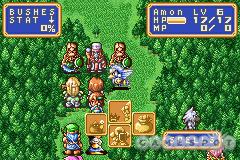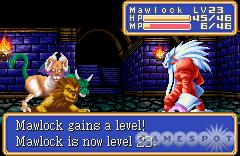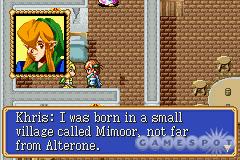It shouldn't come as any surprise that, just like so many other games in the GBA's library, Shining Force: Resurrection of the Dark Dragon is a remake of a game that originally appeared on a 16-bit system back in the early 1990s. What is surprising, however, is that with just a handful of upgrades, Sega and Atlus have taken one of the best strategy role-playing games on the Sega Genesis and have made it into one of the best strategy RPGs on the Game Boy Advance. Those of you who have played Nintendo's Fire Emblem to death will want to check out Shining Force: Resurrection of the Dark Dragon.

The story isn't all that unique, but it works. Long ago, an evil monster called the Dark Dragon was sealed away by the gods. All was peaceful for a thousand years, until the king of Runefaust found out about the slumbering beast and decided to wake it from its thousand-year sleep. The key to freeing the monster is a book that's located somewhere on the peace-loving continent of Rune. Runefaust invades Rune in an effort to find the book, and, sadly, most of Rune's knights are killed in the process. One of the survivors is a young knight-in-training named Max, who also happens to be the hero character in the game. As often happens in these kinds of games, Max can't remember anything about his past. You can pretty much guess the rest. Max is recruited by Rune to put together an army to resist Runefaust, and while he's traveling from one village to the next, he ultimately regains his memories and confronts the king of Runefaust, the Dark Dragon, and the whole host of shady figures that are behind the whole thing.
Those shady figures and all of the other characters in the game are what make the otherwise flat story seem interesting. Every village is full of people to talk to. They'll tell you their life stories, fill you in on historical events, and often give you clues as to what Runefaust's army is up to and where to go next. Also in each village, you'll come across fighters that are willing to join your cause. You can control these various knights, mercenaries, beastmen, and birdmen on the battlefield, and each of these characters has a story to tell, which you can read in bits and pieces by talking to them in your headquarters between battles. The dialogue is charming and well written. Just by tapping the talk button a few times, you can uncover characters' life stories and learn all sorts of information about your mission and the society as a whole. By the last battle, you feel like you've developed a kinship with many of the characters and have a good sense of whom and what you're fighting for.

Still, chances are you're not just looking for this sort of game because it does a good job of telling a story. You're interested because it's a turn-based strategy game that you hope has long chesslike battles that can take an hour or more to finish. It does. When you combine the time it takes to complete the prebattle setup and the time necessary to finish a battle, it's easy to watch an hour just fly by. And Shining Force: Resurrection of the Dark Dragon clocks in with more than 40 different battles spread throughout eight chapters, which adds up to at least 40 hours of playing time.
Battles can take a while, but you'll also spend a fair amount of time setting up for each battle. The CPU can bring upward of 30 individual units onto the battlefield, but you're limited to a maximum of 12--which you choose from an overall roster that grows every time you recruit a new character. It doesn't take long to compile a roster of more than 30 different fighters. Some character types have an advantage over others--barbarians can dole out huge damage to knights, while archers and other long-range units can decimate dragons and other flying units. Some character types are just handy to have around--knights can travel farther since they ride on horseback, healers can help you recover hit points, archers and mages can attack enemies located from two or three squares beyond their movement range, and some characters can cast spells that will affect an entire group of enemies. At times, terrain becomes a factor as well. Knights and mechanized units are strong and can move quickly over flat land and rivers, but their mobility is slashed in half in forests and mountains. There are dozens of different character types to pick from, including, but certainly not limited to, knights, barbarians, mages, assassins, beastmen, birdmen, and mechanized robots. Characters gain experience when they attack enemies, and their various stats (attack, defense, hit points, magic points, agility, speed, and magic resistance) go up every time their experience reaches a certain level. Characters can also be promoted when their rank reaches 10 or above. As you can see, between picking the best units for the situation and trying to level up particular characters, there's a healthy amount of push and pull that goes into just organizing your army before a battle even starts.
Out on the battlefield, Shining Force shares a great deal in common with games like Fire Emblem and Final Fantasy Tactics. The turn-based setup, unit types, and terrain types are pretty much identical between all three games. The setting for each battle is a large rectangular map that can contain a variety of different terrains, such as forests, mountains, rivers, and grasslands. The conditions for a victory vary, but a win usually involves eliminating all of the enemy's units, defeating a boss character, or reaching a particular spot on the map. Typically, your units start out situated in one area of the map, and the enemy's units are spread out in small groups at various strategic spots. The idea here is that you and the CPU will take turns moving units and making attacks. Once a unit's hit points are depleted, it's out of commission. During a turn, you can move each of your units any number of spaces in their movement range and perform one action per unit--make an attack, cast a spell, use an item, or wait. The order in which you and the CPU can make moves is set based upon the speed rating of each unit. Faster units can take their turns sooner, while slower units have to wait. Generally, this means that you and the CPU will alternate moving a few units at a time until the overall turn is over.

Of course, just as there are key differences that distinguish Fire Emblem from Final Fantasy Tactics, there are aspects that help set Shining Force apart. For instance, allies that lose their HP in battle don't stay dead like the units do in other tactics games. If a unit falls in battle, you can revive it by visiting the priest later on. Another big difference has to do with the elemental weaknesses that some units have. Many units are weak to a particular type of spell--either to fire, ice, wind, or electricity. Sometimes, the weakness is obvious, such as desert monsters and ice or forest monsters and fire. Other times, you'll discover purely by accident that a particular unit is weak to a particular element.
The main thing that Shining Force does differently from other strategy RPGs is that it lets you interact with villagers and manage your inventory like a traditional role-playing game would. Inside each village, you can enter houses, talk to people, take items from chests, go on brief fetch quests, and purchase items and weapons from shops to put in your inventory. Each character has its own inventory--they can carry one weapon, three magical charms, and up to four supporting items (such as alternative weapons or healing herbs)--but there's a common group inventory as well. This is nice, because if a character is loaded down and tries to pick something up during a battle, you won't miss out. The item will just end up in the item box instead of being carried by a specific character.
By now, those of you who played Shining Force when it originally came out on the Genesis are probably wondering what's so special about this version--what did Sega do to make this version better besides just making it portable? Well, for starters, the character portraits and battle poses have been redrawn, and a variety of new visual effects were added to make spells and attacks look spiffier. New sound and voice effects were put in as well. Character stats have been rebalanced so that there aren't any particularly overwhelming or overly weak units. Story epilogues have been inserted between chapters, and it turns out that they're fairly significant--partially because they cover what happens in Runefaust whenever Max wins a battle, but mainly because they introduce three new playable characters to the GBA version that weren't in the original Sega Genesis game. In a potentially disgusting move, a card-collecting subquest was also put in. But, amazingly enough, it isn't just a contrived gimmick meant to draw in fans of Pokémon and Yu-Gi-Oh. One of the new characters can actually equip the cards you find and use them to turn into the characters and monsters shown on the cards. Since some cards allow you to damage the entire enemy army even before you've made your first move, the card subquest is actually a fairly useful and significant new addition.

The new additions and touch-ups do help this remake hold its own against the likes of Fire Emblem and Final Fantasy Tactics, but more should have been done to make the graphics and audio seem less Genesis-like and more like what we've become accustomed to seeing and hearing on the GBA. The battle maps and villages look pretty plain, mainly because the tiles used to put them together use the same variety of blue, green, purple, and gray hues that the Genesis version had. The side-view backdrops and various animations that are shown during attacks are lively and inspired and have been retouched for the better, but they're still not quite as sharp or as clean as the animations in Fire Emblem. The same sort of misgivings are true for the audio. The music is operatic and memorable--a real testament to the things that could be accomplished on the 8-bit sound chip in the Genesis--but the developers didn't do much to clean up the scratchiness or hissing that accompanied the original soundtrack. The variety of different weapon and voice effects is good, although you'll notice a bit of audible scratchiness there too.
In the end, if you consider yourself a fan of the strategy-tactics RPG genre, you're not going to mind that the graphics are a little outdated or that the audio has some hissing and popping in it. Shining Force: Resurrection of the Dark Dragon is just too good to pass up.